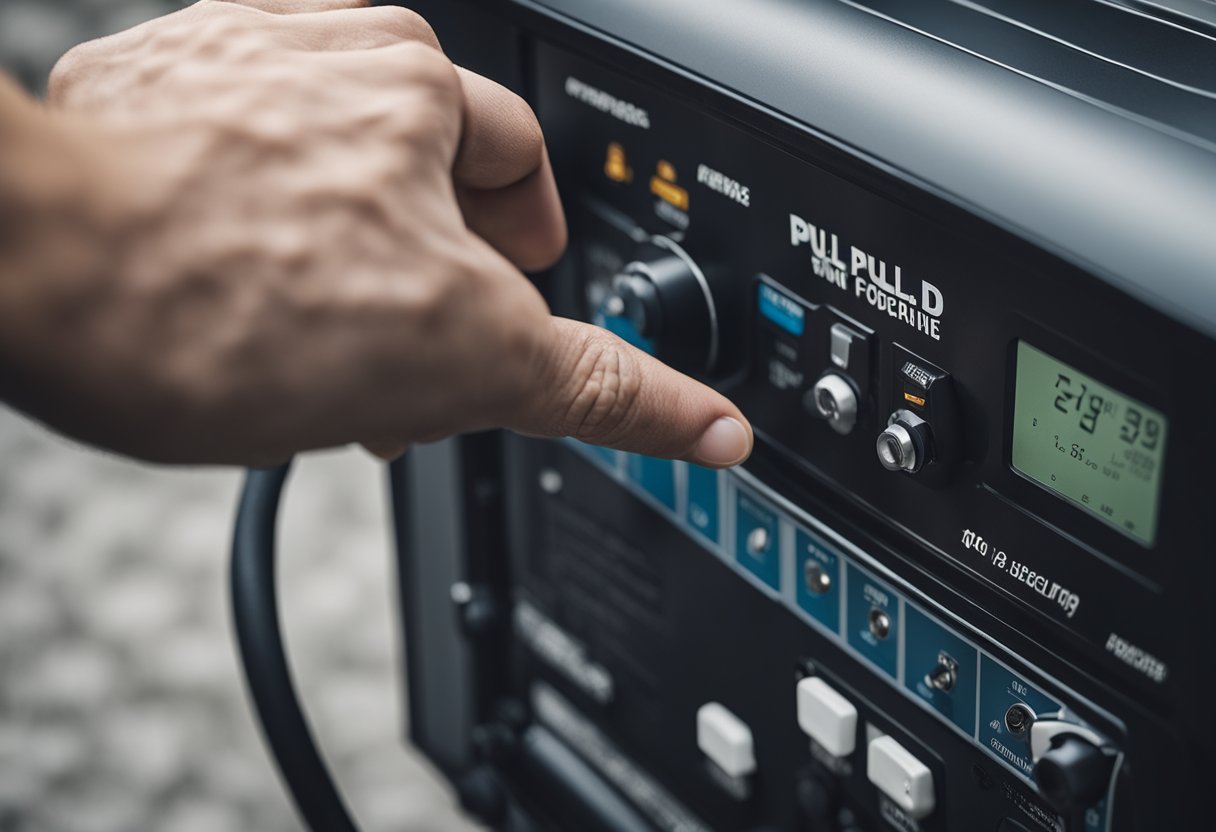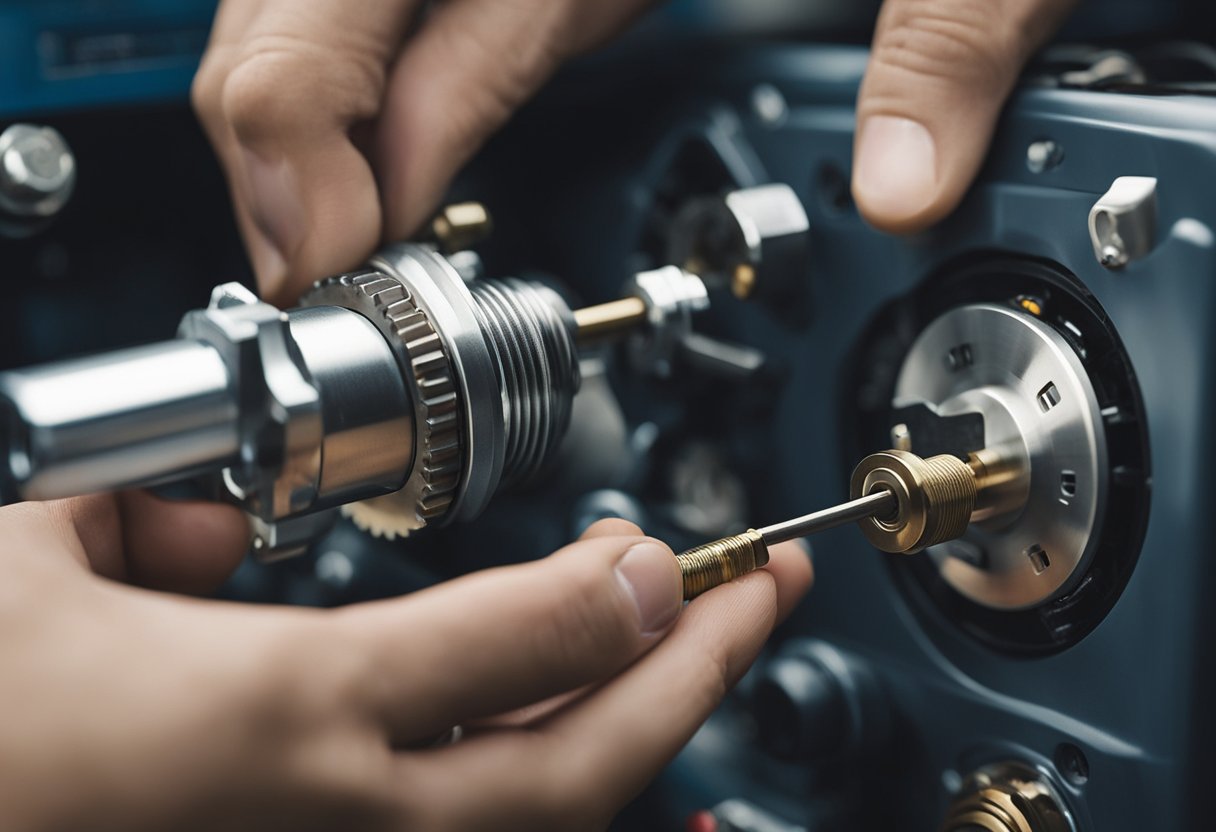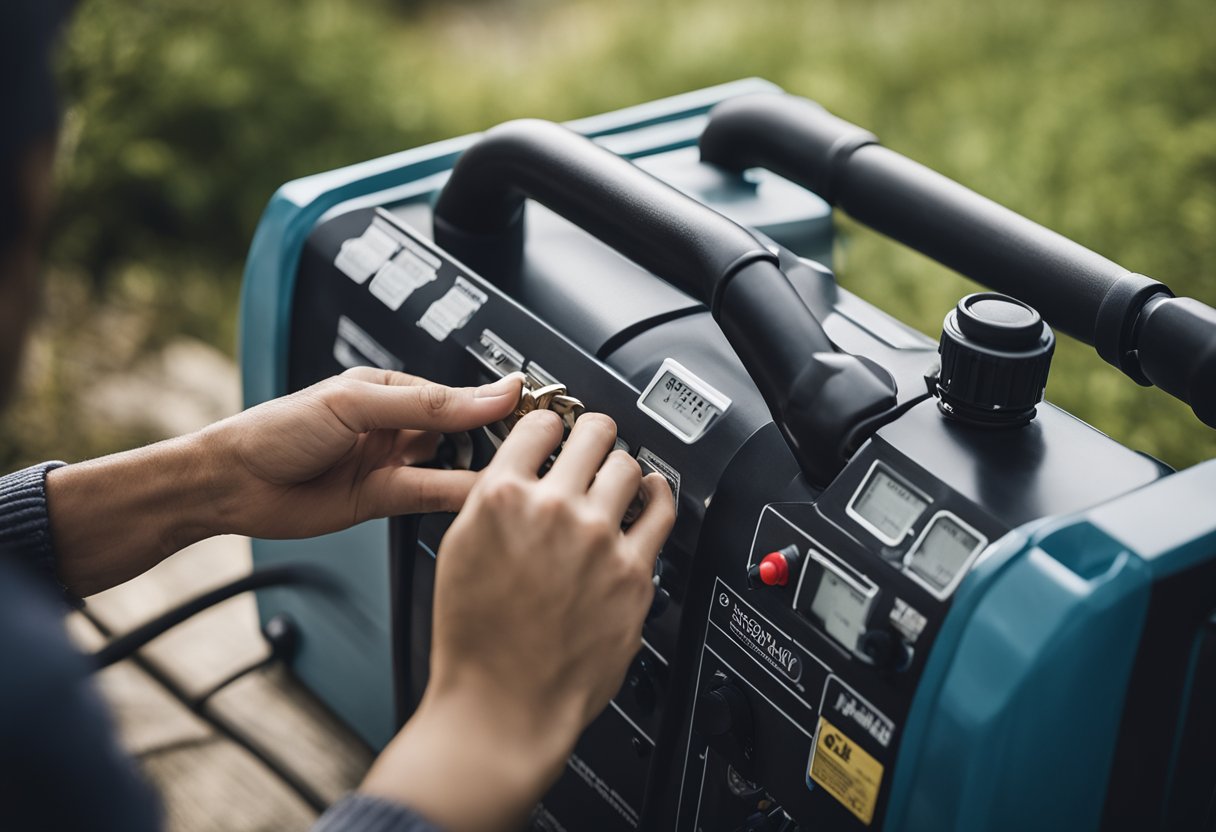Starting a generator without a key can be a daunting task, especially if you have never done it before. Whether you have lost the key or the ignition system is not working, there are several ways to start a generator without a key. In this article, I will guide you through the process of starting a generator without a key, step by step.

Before we dive into the details of starting a generator without a key, it is important to understand the basic components of a generator and how they work. A generator is a machine that converts mechanical energy into electrical energy. It consists of an engine, an alternator, a fuel tank, and a battery. The engine is the heart of the generator, and it is responsible for converting fuel into mechanical energy. The alternator converts this mechanical energy into electrical energy, which is then distributed through the outlets on the generator.
To start a generator without a key, you will need to follow a few simple steps. First, you will need to prepare the generator by checking the fuel level, oil level, and air filter. Next, you will need to locate the ignition switch and the starter motor. Depending on the type of generator you have, you may need to use a rope starter or a button starter to turn the engine over. With a little patience and some basic knowledge, you can start your generator without a key and have power when you need it most.
Understanding Generators
https://www.youtube.com/watch?v=qUPlS__HuSA&embed=true
As someone who has worked with generators for several years, I understand the importance of having a reliable power source. Generators are devices that convert mechanical energy into electrical energy. They come in various sizes, from small portable generators to large standby generators that can power entire homes or buildings.
Portable generators are the most common type of generators and are usually powered by gasoline or diesel engines. They are designed to be moved around and can be used for a variety of purposes, such as powering tools on a construction site or providing electricity during a power outage.
Standby generators, on the other hand, are permanently installed and are connected to a home or building’s electrical system. They are designed to turn on automatically when there is a power outage and can provide power for days or even weeks. Generac generators are a popular brand of standby generators that are known for their reliability and ease of use.
When it comes to starting a generator without a key, it’s important to understand the different types of engines that generators use. Honda engines, for example, are known for their durability and fuel efficiency. They are commonly used in portable generators and are easy to maintain.
To start a generator without a key, you may need to bypass the ignition switch and connect the ignition wires together. Alternatively, you could use the recoil starter to manually start the generator. It’s important to note that these methods should only be used in emergencies and that safety should always be a top priority.
In summary, generators are essential devices that provide backup power in case of emergencies or power outages. They come in various sizes and types, including portable and standby generators. Understanding the different types of engines and starting mechanisms can help you troubleshoot any issues that may arise.
Preparation Before Starting a Generator

Before starting a generator without a key, it is essential to prepare your generator for a successful start-up. Proper preparation not only ensures a smooth start-up, but also prolongs the life of your generator. Here are a few things to consider before starting a generator without a key:
1. Check the Manual
Before starting the generator, it is essential to read the manual carefully. The manual will provide you with all the necessary information about your generator, including how to start it without a key. It will also provide you with safety precautions that you need to take before starting your generator.
2. Check the Oil Level
Checking the oil level is crucial before starting the generator. Low oil levels can cause damage to the engine. Make sure that the oil level is between the minimum and maximum marks on the dipstick. If the oil level is low, add oil as per the manufacturer’s instructions.
3. Check the Fuel System
Check the fuel valve and make sure it is in the “on” position. Also, check the fuel tank and make sure that it has enough fuel. Low fuel levels can cause the generator to stop running. If the fuel levels are low, add fuel as per the manufacturer’s instructions.
4. Check the Air Filter
The air filter is an essential component of the generator. It prevents dust and debris from entering the engine. Check the air filter and make sure it is clean. If it is dirty, clean or replace it as per the manufacturer’s instructions.
5. Check the Spark Plugs
The spark plugs are responsible for igniting the fuel in the engine. Check the spark plugs and make sure they are clean and in good condition. If they are dirty or damaged, clean or replace them as per the manufacturer’s instructions.
6. Take Safety Precautions
Generators produce carbon monoxide, which is a poisonous gas. It is essential to take safety precautions before starting the generator. Make sure that the generator is placed in a well-ventilated area. Do not run the generator in an enclosed space. Also, make sure that the generator is not touching any combustible material.
In conclusion, before starting a generator without a key, it is crucial to prepare your generator for a successful start-up. Checking the oil level, fuel system, air filter, spark plugs, and taking safety precautions are critical steps to ensure the generator runs smoothly.
Key Components of a Generator Ignition System

As someone who has started many generators, I can tell you that the ignition system is one of the most important components of a generator. The ignition system is responsible for starting the engine, which in turn generates electricity.
There are two types of ignition systems: electric start and recoil start. Electric start generators have a battery that provides power to the starter motor, while recoil start generators require you to pull a cord to start the engine.
The ignition switch is another important component of the ignition system. It is the switch that turns the engine on and off. Some generators come with keys that are used to start the engine, while others do not require keys.
The ignition wires are responsible for transmitting the electrical current from the battery to the starter motor. These wires are usually color-coded and can be easily identified.
The choke is also an important component of the ignition system. It is a lever that is used to restrict the air flow to the carburetor, which in turn makes it easier to start the engine.
The throttle is another component of the ignition system. It is a lever that is used to control the speed of the engine.
The carburetor is responsible for mixing air and fuel to create a combustible mixture that is used to power the engine. The fuel filter is another important component that helps to ensure that the fuel that is used to power the engine is clean and free of contaminants.
Finally, the black wire is a grounding function wire that is used for the ignition system. It is important to locate this wire when starting a generator without a key, as it needs to be disconnected to bypass the ignition switch.
Overall, the ignition system is a complex system that is responsible for starting the engine and generating electricity. By understanding the key components of the ignition system, you can troubleshoot any issues that you may encounter when starting your generator.
How to Start a Generator Without a Key
https://www.youtube.com/watch?v=Q0SP9WN1AKY&embed=true
Starting a generator without a key may seem like a daunting task, but with a few simple steps, you can get your generator up and running in no time. Here are some tips to help you start your generator without a key:
-
Check the Power Cord – Ensure that the power cord is properly connected to the generator and the power source. If the cord is damaged, replace it before attempting to start the generator.
-
Monitor the Power Output – Before starting the generator, make sure that the power output is appropriate for the devices you want to use. If the output is too high, it can cause damage to your devices, and if it’s too low, they may not function properly.
-
Use a Transfer Switch – If you have a hard-wired generator, use an automatic transfer switch to safely and efficiently transfer power from the generator to your home or business.
-
Bypass the Key – If you have lost your key or the ignition switch is not working, you can bypass the key by connecting the ignition wires together. This will allow you to start the generator without a key.
-
Safety First – Always prioritize safety when starting a generator without a key. Make sure that the generator is in a well-ventilated area and away from any flammable materials. Never attempt to start a generator that is emitting smoke or flames.
By following these simple steps, you can safely and efficiently start your generator without a key. Remember to always prioritize safety and monitor the power output to ensure that your devices are functioning properly.
Maintenance and Monitoring of Generators

As a generator owner, it is crucial to ensure that your generator is maintained and monitored regularly. Proper maintenance and monitoring can extend the life of your generator, prevent costly repairs, and ensure that your generator is always ready to use when you need it.
One of the most important aspects of generator maintenance is regular refueling. Running out of fuel can cause damage to your generator, so it is important to keep your generator’s fuel tank full. It is also important to use the right type of fuel for your generator, as using the wrong type of fuel can cause damage.
In addition to refueling, it is important to regularly check and replace the oil and fuel filters in your generator. Dirty filters can cause your generator to run inefficiently and can even cause damage. It is also important to keep the air filter clean, as a dirty air filter can reduce the performance of your generator.
Coolant levels should also be checked regularly, as low coolant levels can cause your generator to overheat. Spark plugs should be checked and replaced as needed, as worn or dirty spark plugs can cause your generator to run poorly or not start at all.
Finally, it is important to monitor the battery of your generator. A dead battery can prevent your generator from starting, so it is important to keep the battery charged and replace it as needed.
Regular maintenance and monitoring can help ensure that your generator is always ready to use when you need it. It is also important to keep track of your generator’s warranty, as some maintenance tasks may be covered under warranty.
Safety Precautions When Operating Generators
https://www.youtube.com/watch?v=t0CPpbAwi08&embed=true
As someone who has operated generators for years, I know that safety is of utmost importance. Here are some safety precautions you should take when operating a generator:
Carbon Monoxide Poisoning
Carbon monoxide is a colorless, odorless, and tasteless gas that can cause illness or death. Generators produce carbon monoxide, so it is important to never use a generator indoors or in an enclosed space, such as a garage or basement. Always place the generator outdoors in a well-ventilated area, away from windows, doors, and vents that could allow carbon monoxide to enter the building.
Fire
Generators can get hot and cause fires, so it is important to keep them away from flammable materials. Do not place the generator near combustible materials such as leaves, grass, paper, or wood. Make sure the generator has plenty of space around it for air flow and cooling.
Refueling
When refueling a generator, turn it off and let it cool down before adding fuel. Gasoline is highly flammable and can ignite if it comes into contact with a hot surface. Do not overfill the fuel tank and never add fuel while the generator is running.
Power Cord and Extension Cords
Make sure the power cord and extension cords are in good condition and rated for the generator’s wattage. Do not use damaged cords or cords with exposed wires. Keep cords away from water and do not use them in wet conditions.
Breaker
Before starting the generator, make sure the circuit breaker is in the off position. This will prevent the generator from sending power back into the utility grid, which could injure or kill utility workers who are repairing power lines.
By following these safety precautions, you can operate your generator safely and avoid accidents.
Conclusion

Starting a generator without a key is a useful skill to have, especially during emergencies or when you misplace the key. In this article, I have provided several methods to start a generator without a key, including hot-wiring, bypassing the ignition switch, and using a screwdriver to turn the engine switch.
When attempting to start a generator without a key, it is important to prioritize safety precautions. Always ensure that the generator is on a level surface, and that there are no flammable materials nearby. Additionally, make sure to wear protective gear such as gloves and goggles.
If you are starting a brand new generator for the first time, it is important to read the generator manual thoroughly before attempting to start the generator. This will ensure that you are familiar with the generator’s features and safety precautions.
Once you have successfully started the generator, it is important to let the generator run for a few minutes before connecting any appliances. This will allow the generator to warm up and stabilize, ensuring that it can handle the load of any connected appliances.
In conclusion, starting a generator without a key is a simple process that requires the right tools and knowledge. By following the methods outlined in this article and prioritizing safety precautions, you can start your generator quickly and efficiently.
Frequently Asked Questions
https://www.youtube.com/watch?v=Nkg6IypPC0Y&embed=true
How to start a generator without a key or battery?
If your generator does not have a key or battery, you can start it manually. First, make sure that the fuel valve is open and the choke is engaged. Then, pull the recoil starter cord firmly until the engine starts. If the engine does not start after a few pulls, wait a few minutes and try again.
How to start a generator manually?
To start a generator manually, make sure that the fuel valve is open and the choke is engaged. Then, pull the recoil starter cord firmly until the engine starts. If the engine does not start after a few pulls, wait a few minutes and try again. Once the engine is running, turn off the choke and let the generator warm up for a few minutes before connecting any devices.
How do you start a generator with a drill?
Starting a generator with a drill is possible, but it should only be done in an emergency situation. To do so, remove the spark plug from the engine and insert a socket wrench into the hole. Turn the socket wrench counterclockwise to turn the engine over. Once the engine is turning, replace the spark plug and try starting the generator manually or with the electric starter.
Can you jump start a generator with a car battery?
It is possible to jump start a generator with a car battery, but it is not recommended. The voltage output of a car battery is much higher than that of a generator battery, which can damage the generator’s electrical components. If you must jump start a generator with a car battery, make sure to use a set of jumper cables with a built-in voltage regulator.
How does a generator start with a battery?
Generators with electric starters use a battery to power the starter motor. When the starter button or key is pressed, the starter motor turns the engine over until it starts. Once the engine is running, the battery is recharged by the generator’s alternator.
How to open Generac generator without key?
If you have lost the key to your Generac generator, you can still start it manually. First, make sure that the fuel valve is open and the choke is engaged. Then, locate the starter solenoid on the generator and use a screwdriver to bridge the two terminals. This will send power to the starter motor and turn the engine over. Once the engine is running, turn off the choke and let the generator warm up for a few minutes before connecting any devices.

Hi, I’m Sal Muller of Tooltrip.com. My DIY experience led me to understand essential power tools for home projects. Tooltrip.com guides enthusiasts and professionals in choosing right tools for any job. I provide concise top tool reviews for easier, efficient DIY.

